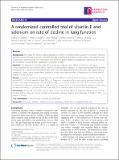| dc.contributor.author | Cassano, Patricia A | en_US |
| dc.contributor.author | Guertin, Kristin A | en_US |
| dc.contributor.author | Kristal, Alan R | en_US |
| dc.contributor.author | Ritchie, Kathryn E | en_US |
| dc.contributor.author | Bertoia, Monica L | en_US |
| dc.contributor.author | Arnold, Kathryn B | en_US |
| dc.contributor.author | Crowley, John J | en_US |
| dc.contributor.author | Hartline, JoAnn | en_US |
| dc.contributor.author | Goodman, Phyllis J | en_US |
| dc.contributor.author | Tangen, Catherine M | en_US |
| dc.contributor.author | Minasian, Lori M | en_US |
| dc.contributor.author | Lippman, Scott M | en_US |
| dc.contributor.author | Klein, Eric | en_US |
| dc.date.accessioned | 2015-05-04T15:26:14Z | |
| dc.date.issued | 2015 | en_US |
| dc.identifier.citation | Cassano, P. A., K. A. Guertin, A. R. Kristal, K. E. Ritchie, M. L. Bertoia, K. B. Arnold, J. J. Crowley, et al. 2015. “A randomized controlled trial of vitamin E and selenium on rate of decline in lung function.” Respiratory Research 16 (1): 35. doi:10.1186/s12931-015-0195-5. http://dx.doi.org/10.1186/s12931-015-0195-5. | en |
| dc.identifier.issn | 1465-9921 | en |
| dc.identifier.uri | http://nrs.harvard.edu/urn-3:HUL.InstRepos:15034826 | |
| dc.description.abstract | Background: The intake of nutrients with antioxidant properties is hypothesized to augment antioxidant defenses, decrease oxidant damage to tissues, and attenuate age-related rate of decline in lung function. The objective was to determine whether long-term intervention with selenium and/or vitamin E supplements attenuates the annual rate of decline in lung function, particularly in cigarette smokers. Methods: The Respiratory Ancillary Study (RAS) tested the single and joint effects of selenium (200 μg/d L-selenomethionine) and vitamin E (400 IU/day all rac-α-tocopheryl acetate) in a randomized double-blind placebo-controlled trial. At the end of the intervention, 1,641 men had repeated pulmonary function tests separated by an average of 3 years. Linear mixed-effects regression models estimated the effect of intervention on annual rate of decline in lung function. Results: Compared to placebo, intervention had no main effect on either forced expiratory volume in the first second (FEV1) or forced expiratory flow (FEF25–75). There was no evidence for a smoking by treatment interaction for FEV1, but selenium attenuated rate of decline in FEF25–75 in current smokers (P = 0.0219). For current smokers randomized to selenium, annual rate of decline in FEF25–75 was similar to the annual decline experienced by never smokers randomized to placebo, with consistent effects for selenium alone and combined with vitamin E. Conclusions: Among all men, there was no effect of selenium and/or vitamin E supplementation on rate of lung function decline. However, current smokers randomized to selenium had an attenuated rate of decline in FEF25–75, a marker of airflow. Trial registration Clinicaltrials.gov identifier: NCT00241865. Electronic supplementary material The online version of this article (doi:10.1186/s12931-015-0195-5) contains supplementary material, which is available to authorized users. | en |
| dc.language.iso | en_US | en |
| dc.publisher | BioMed Central | en |
| dc.relation.isversionof | doi:10.1186/s12931-015-0195-5 | en |
| dc.relation.hasversion | http://www.ncbi.nlm.nih.gov/pmc/articles/PMC4404242/pdf/ | en |
| dash.license | LAA | en_US |
| dc.subject | Spirometry | en |
| dc.subject | Vitamin E | en |
| dc.subject | Selenium | en |
| dc.subject | Forced expiratory volume | en |
| dc.subject | Forced expiratory flow rate | en |
| dc.title | A randomized controlled trial of vitamin E and selenium on rate of decline in lung function | en |
| dc.type | Journal Article | en_US |
| dc.description.version | Version of Record | en |
| dc.relation.journal | Respiratory Research | en |
| dash.depositing.author | Bertoia, Monica L | en_US |
| dc.date.available | 2015-05-04T15:26:14Z | |
| dc.identifier.doi | 10.1186/s12931-015-0195-5 | * |
| dash.authorsordered | false | |
| dash.contributor.affiliated | Bertoia, Monica | |


